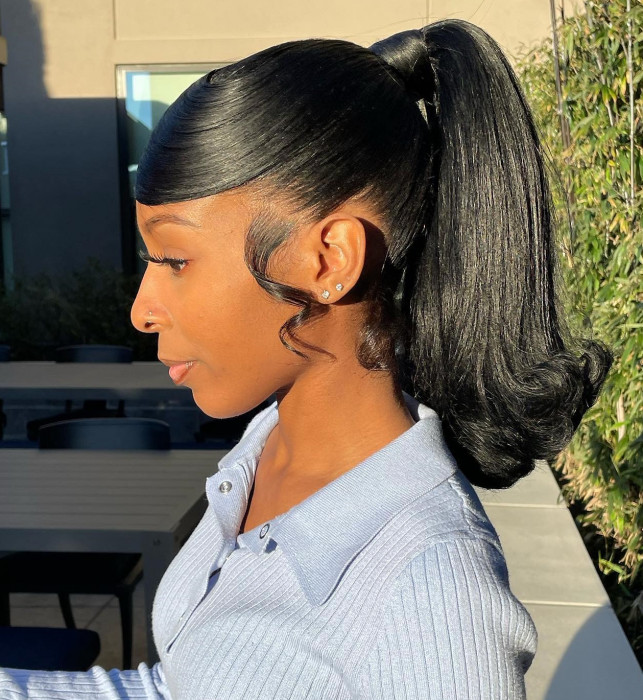Creating a voluminous ponytail has become a timeless goal for many, but achieving it requires more than just styling techniques. Tracking hair growth plays a pivotal role in ensuring your ponytail looks fuller and healthier over time. Whether you're looking to grow out your hair for a longer ponytail or maintain its health, understanding how to track hair for ponytail success is essential. This guide dives deep into strategies, tips, and insights to help you achieve the ponytail of your dreams while promoting healthy hair growth.
With countless individuals seeking ways to enhance their ponytail's appearance, tracking hair progress has emerged as a practical solution. By monitoring your hair's growth and health, you can identify areas for improvement and implement effective strategies to achieve optimal results. This article will explore various methods, tools, and expert advice to help you stay on top of your hair journey, ensuring your ponytail remains vibrant and full.
As we delve into the specifics of tracking hair for ponytail, it's important to remember that consistency and patience are key. From understanding your hair type to incorporating the right products and routines, this guide will provide actionable insights to help you achieve the ponytail you've always desired. Let's get started!
Read also:Fortuna Towing Your Reliable Partner For Automotive Solutions
Table of Contents
- What Does Tracking Hair for Ponytail Involve?
- Why Should You Track Hair for Ponytail?
- How Often Should You Track Hair for Ponytail?
- What Tools Are Best for Tracking Hair Growth?
- Tips for Maintaining Healthy Hair for a Flawless Ponytail
- Is It Necessary to Adjust Your Routine When Tracking Hair for Ponytail?
- Common Mistakes to Avoid While Tracking Hair for Ponytail
- How Can You Measure Success in Tracking Hair for Ponytail?
- What Are Some Natural Remedies to Boost Hair Growth for Ponytail?
- Final Thoughts on Tracking Hair for Ponytail
What Does Tracking Hair for Ponytail Involve?
Tracking hair for ponytail primarily involves monitoring your hair's growth and health over time. This process includes taking regular measurements, documenting changes, and evaluating the effectiveness of your current hair care routine. By keeping a close eye on your hair's progress, you can identify potential issues early and make necessary adjustments to your regimen. Whether you're tracking hair for ponytail growth or overall health, consistency is key to achieving optimal results.
Why Should You Track Hair for Ponytail?
There are several reasons why tracking hair for ponytail is beneficial. Firstly, it allows you to set realistic goals and track your progress toward achieving them. Secondly, it helps you identify patterns or issues that may be affecting your hair's growth or health. Lastly, tracking hair for ponytail provides valuable insights into what works and what doesn't, enabling you to refine your routine for better outcomes. This proactive approach can lead to healthier, fuller hair and a more satisfying ponytail experience.
How Often Should You Track Hair for Ponytail?
Frequency is an important factor when tracking hair for ponytail. Experts recommend tracking your hair's growth and health at least once a month. This allows you to observe gradual changes and make timely adjustments to your routine. However, the exact frequency may vary depending on your hair type, growth rate, and personal preferences. Ultimately, finding a schedule that works for you is crucial to maintaining consistency and achieving your desired results.
What Tools Are Best for Tracking Hair Growth?
Various tools and methods can help you effectively track hair for ponytail. Some popular options include:
- Measuring tape: Use a flexible measuring tape to measure the length of your hair regularly.
- Photography: Take consistent photos of your hair to visually track its progress over time.
- Journaling: Keep a detailed journal of your hair care routine, noting any changes or observations.
- Apps: Utilize hair tracking apps designed to simplify the process and provide valuable insights.
Experiment with different tools to find the ones that best suit your needs and preferences.
Tips for Maintaining Healthy Hair for a Flawless Ponytail
To ensure your ponytail remains vibrant and full, consider incorporating the following tips into your routine:
Read also:Who Played Maime Le Mal
- Use gentle, sulfate-free shampoos and conditioners to prevent damage.
- Protect your hair from heat by using heat protectant sprays and limiting the use of styling tools.
- Stay hydrated and consume a balanced diet rich in vitamins and minerals to promote healthy hair growth.
- Regularly trim your hair to eliminate split ends and encourage new growth.
- Massage your scalp daily to stimulate blood flow and promote hair growth.
Is It Necessary to Adjust Your Routine When Tracking Hair for Ponytail?
As you track hair for ponytail, you may notice areas where your current routine falls short. In such cases, adjusting your regimen to address these issues can significantly improve your results. For example, if you notice excessive breakage, consider incorporating more protective styling techniques into your routine. Similarly, if your hair isn't growing as expected, you may need to evaluate your diet and supplement intake. Being open to change and willing to adapt is essential for achieving the best possible outcomes.
Common Mistakes to Avoid While Tracking Hair for Ponytail
While tracking hair for ponytail, it's important to avoid common pitfalls that could hinder your progress. Some mistakes to watch out for include:
- Overusing heat tools, which can lead to damage and breakage.
- Skipping regular trims, allowing split ends to accumulate and affect overall hair health.
- Not staying consistent with your tracking efforts, leading to incomplete or inaccurate data.
- Ignoring scalp health, which can impact hair growth and overall hair quality.
Avoiding these mistakes will help you maintain a healthy, thriving ponytail.
How Can You Measure Success in Tracking Hair for Ponytail?
Measuring success in tracking hair for ponytail involves evaluating various factors, such as:
- Increased hair length and thickness over time.
- Improved hair health, including reduced breakage and split ends.
- Enhanced ponytail volume and overall appearance.
- Greater satisfaction with your hair care routine and results.
By focusing on these key indicators, you can determine whether your tracking efforts are paying off and make adjustments as needed.
What Are Some Natural Remedies to Boost Hair Growth for Ponytail?
Incorporating natural remedies into your hair care routine can boost hair growth and enhance your ponytail's appearance. Some effective options include:
- Using aloe vera gel to moisturize and strengthen your hair.
- Massaging your scalp with coconut oil or olive oil to stimulate growth.
- Incorporating biotin-rich foods, such as eggs and nuts, into your diet.
- Applying herbal masks, like those containing rosemary or peppermint, to promote circulation.
Experiment with these remedies to find the ones that work best for your hair type and goals.
Final Thoughts on Tracking Hair for Ponytail
Tracking hair for ponytail is an essential practice for anyone looking to achieve a fuller, healthier ponytail. By consistently monitoring your hair's growth and health, you can identify areas for improvement and implement effective strategies to achieve your desired results. Remember to stay patient and consistent in your efforts, as achieving a lush ponytail takes time and dedication. With the right tools, tips, and mindset, you can successfully track hair for ponytail and enjoy the beautiful results.


